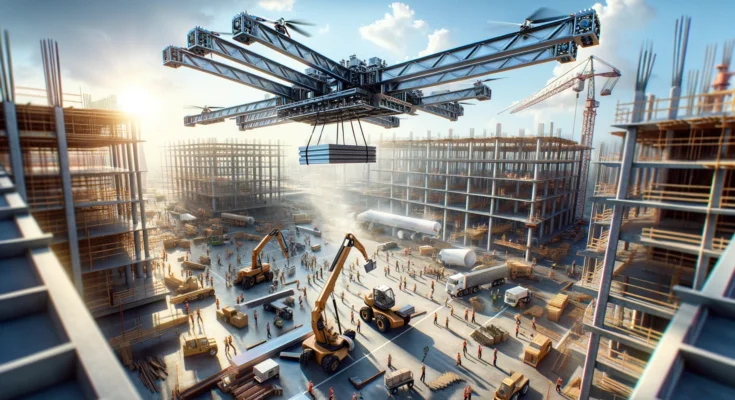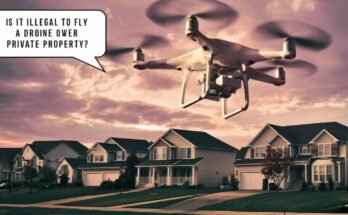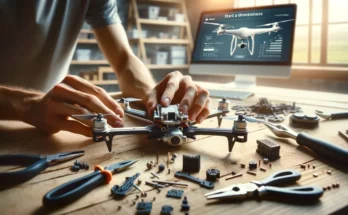Imagine a powerful machine that can access hard-to-reach areas, capture high-resolution data, and improve efficiency across various tasks. This is the reality of industrial drones. These unmanned aerial vehicles (UAVs) are rapidly transforming industries, offering businesses a new level of control and insight.
Whether you’re in construction, agriculture, or public safety, industrial drones can provide significant advantages. In this article, we’ll delve into the exciting world of industrial drones, exploring their types, applications, and the benefits they bring to various sectors. We’ll also address key considerations like choosing the right drone and the future outlook for this revolutionary technology.
Types of Industrial Drones and Their Uses
Industrial drones are no longer science fiction. These unmanned aerial vehicles (UAVs) come in a variety of shapes and sizes, each with unique capabilities suited for specific applications. Here’s a breakdown of some common types of industrial drones:
-
Multicopters:
Imagine a helicopter with multiple rotors – that’s a multicopter! These versatile drones are known for their excellent maneuverability and stability, making them ideal for tasks requiring precision and control. Common applications include aerial photography and videography, data collection for inspections, and precision agriculture tasks like crop spraying. Popular multicopter manufacturers include DJI Enterprise (https://enterprise.dji.com/) and PrecisionHawk (https://www.precisionhawk.com/drones), offering a range of models with varying payload capacities and features.
-
Fixed-Wing Drones:
These drones resemble small airplanes, boasting longer flight times and excellent range compared to multicopters. Fixed-wing drones excel in covering large areas for tasks like aerial mapping, surveying, and pipeline inspections. Their longer flight times make them suitable for data collection over vast landscapes. Companies like Aerosystems West ([https://aerosystemswest.com/hlm-quadcopter/]) specialize in fixed-wing drone solutions.
-
Heavy-Lift Drones:
As the name suggests, these powerful drones are built to carry significant payloads, making them ideal for construction tasks. Imagine lifting materials or transporting equipment to remote locations – that’s where heavy-lift drones come in. Their robust design and powerful motors allow them to handle substantial weight, increasing efficiency and safety in construction projects.
Choosing the Right Industrial Drone: A Multi-Factored Decision
Selecting the perfect industrial drone for your needs requires careful consideration of several factors. Here’s a breakdown of key aspects to ponder before making your decision:
-
Application:
First and foremost, identify the specific task you envision the drone performing. Are you looking for high-resolution aerial photography for construction progress monitoring? Perhaps you need a drone equipped with a multispectral camera for crop health analysis in agriculture. Matching the drone’s capabilities to your intended application is crucial. For instance, tasks requiring close-up inspections might be better suited for a maneuverable multicopter, while fixed-wing drones excel in covering large areas for mapping or surveying.
-
Payload Capacity:
Not all drones are created equal when it comes to lifting power. If your project involves transporting materials or equipment, ensure the drone’s payload capacity meets your requirements. Heavy-lift drones, as discussed earlier, are specifically designed for such tasks, boasting robust construction and powerful motors to handle significant weight. Researching the payload capacity of various models is essential to avoid overloading the drone and compromising safety or performance.
-
Flight Time:
Consider the duration of your desired missions. Imagine needing a drone to capture aerial video of a large construction site – a drone with a longer flight time would be ideal. Conversely, a shorter-duration flight might suffice for a quick inspection task. Battery life directly impacts flight time, so factor this in when comparing different drone models. Manufacturers typically specify flight times in their product descriptions, allowing you to make an informed decision.
-
Regulations:
Before taking flight, it’s crucial to familiarize yourself with local regulations regarding drone operation in your area. These regulations often outline weight restrictions for drones and designate specific flight zones. Violating these regulations can result in hefty fines, so staying informed and compliant is essential. Resources like government websites or drone industry associations can provide you with up-to-date information on regulations in your area.
By carefully considering these factors – application, payload capacity, flight time, and regulations – you can narrow down your options and select the industrial drone that best suits your specific needs and ensures successful completion of your projects.
Benefits of Using Industrial Drones in Various Industries
Industrial drones are rapidly transforming numerous industries by offering a multitude of benefits. Here’s a glimpse into how these innovative UAVs are revolutionizing various sectors:
-
Construction:

Industrial Drones Industrial drones have become a valuable asset in the construction industry. They can be used for aerial inspections of buildings and infrastructure, identifying potential problems or ensuring adherence to building codes. Imagine a drone swiftly scanning a high-rise facade for cracks or damage, eliminating the need for workers to access dangerous heights. Furthermore, drones can be deployed for surveying construction sites, monitoring progress, and creating 3D models for improved project planning. This enhanced efficiency translates to cost savings and faster project completion times.
-
Agriculture:

Agriculture Drones Precision agriculture is a rapidly growing field, and industrial drones play a crucial role in this advancement. Equipped with multispectral cameras, these drones can analyze crop health, detect diseases or pests at an early stage, and optimize the use of fertilizers and water. Imagine a drone capturing high-resolution images of a vast field, pinpointing areas with nutrient deficiencies or potential insect infestations. This allows farmers to apply targeted treatments, minimizing waste and maximizing crop yield. Additionally, drones can be used for precision spraying, applying pesticides or herbicides only to affected areas, reducing environmental impact and promoting sustainable farming practices.
-
Public Safety:
Industrial drones are proving to be invaluable tools for public safety agencies. Search and rescue operations are significantly enhanced with the ability of drones to provide a bird’s-eye view of disaster zones. Imagine a drone quickly locating lost hikers in dense forests or pinpointing survivors trapped in floodwaters. Their maneuverability and ability to access difficult areas make them ideal for such critical missions. Furthermore, drones can be used for fire inspections, identifying hotspots and assisting firefighters in strategizing their response. Traffic monitoring and crowd management are also potential applications of drones in the public safety domain.
-
Energy Sector:
The energy sector benefits from the capabilities of industrial drones in several ways. Imagine a drone inspecting power lines for damage or corrosion, ensuring the safe and reliable transmission of electricity. Similarly, drones can be deployed to inspect wind turbines or solar panels, identifying potential maintenance needs before they escalate into major issues. This proactive approach to maintenance translates to cost savings and improved efficiency in the energy sector. Furthermore, drones can be used for mapping purposes, assisting in planning the installation of new power lines or renewable energy infrastructure.
These are just a few examples of how industrial drones are revolutionizing various industries. As technology continues to evolve and drone capabilities expand, we can expect even more innovative applications to emerge, shaping the future of numerous sectors across the globe.
Key Features of Industrial Drones: Power, Precision, and Intelligence
Industrial drones boast a range of features that make them powerful and versatile tools across various industries. Here’s a breakdown of some key features that contribute to their effectiveness:
-
High-Quality Cameras:
Gone are the days of grainy drone footage. Many industrial drones are equipped with high-resolution cameras, capturing detailed photos and videos that are crucial for data collection and inspections. Imagine a drone capturing crystal-clear images of a building facade, allowing inspectors to identify even minor cracks or structural issues. These high-quality visuals provide valuable insights that would be difficult or even impossible to obtain from the ground. Furthermore, some drones offer features like zoom capabilities or thermal imaging, expanding their data collection potential.
-
Advanced Sensors:
Industrial drones go beyond just capturing visual data. They can be equipped with a variety of advanced sensors to gather even more comprehensive information about their surroundings. Imagine a drone equipped with a LiDAR (Light Detection and Ranging) sensor, creating detailed 3D models of a construction site or a wind turbine. These 3D models provide valuable insights for planning, monitoring progress, and identifying potential issues. Additionally, multispectral sensors can be used in agriculture, analyzing crop health by detecting variations in light reflectance. These advanced sensors transform industrial drones into powerful data collection platforms.
-
Autonomous Flight:
The future of drone operation is increasingly autonomous. Many industrial drones offer features like waypoint navigation or pre-programmed flight plans. Imagine a drone automatically flying a predefined route to inspect a power line corridor, capturing data and images at specific intervals. This reduces the need for constant human intervention and allows for more efficient data collection, particularly over large areas. While some level of human supervision is often necessary, autonomous flight capabilities significantly enhance the usability of industrial drones.
-
Durability and Reliability:
Industrial drones are built to withstand demanding conditions. They are often constructed with lightweight yet robust materials that can handle wind, rain, and even extreme temperatures. Imagine a drone operating effectively in a dusty construction site or capturing data during a snowstorm. This durability ensures reliable performance in various environments, maximizing the operational potential of these aerial platforms.
By combining high-quality cameras, advanced sensors, autonomous flight capabilities, and robust construction, industrial drones provide a powerful and versatile solution for various data collection, inspection, and task execution needs across numerous industries.
The Future of Industrial Drones: A Glimpse into Innovation
The world of industrial drones is full of exciting opportunities. Advancements in technology are poised to push the boundaries of these aerial platforms, leading to even more innovative applications and shaping the future of various sectors. Here’s a glimpse into what we can expect:
-
Extended Flight Times:
One of the key limitations of current drone technology is battery life. However, advancements in battery technology are on the horizon, promising longer flight times for industrial drones. Imagine a drone capable of autonomously surveying a vast agricultural field or monitoring a lengthy pipeline for hours on end. Increased flight times will unlock new possibilities for data collection and inspections over large areas, further enhancing the efficiency and capabilities of industrial drones.
-
Artificial Intelligence Integration:
Artificial intelligence (AI) has the potential to revolutionize drone operation. Imagine a drone equipped with AI that can autonomously identify and inspect potential problems during a building facade inspection, or a drone that can analyze crop health data captured by multispectral sensors and suggest targeted treatments. AI integration will enable drones to perform more complex tasks with greater autonomy and accuracy, further streamlining workflows and maximizing their effectiveness.
-
Advanced Data Processing and Analytics:
The future of industrial drones is not just about data collection, but also about the analysis and interpretation of that data. Imagine powerful software platforms that can analyze drone-captured images and videos, automatically detect anomalies, and generate insightful reports. This advanced data processing will unlock valuable insights that can be used to improve decision-making across various industries. For instance, construction companies could leverage drone data to identify potential delays or safety hazards on a project site, while farmers could use it to optimize fertilizer and water usage based on real-time crop health data.
-
Integration with Existing Infrastructure:
The future holds promise for even greater integration of industrial drones with existing infrastructure. Imagine drones seamlessly interacting with air traffic control systems or automatically uploading captured data to cloud-based platforms for real-time analysis. This level of integration will streamline workflows, enhance data accessibility, and pave the way for even more sophisticated applications of drone technology.
These are just a few examples of what the future holds for industrial drones. As technology continues to evolve and innovation takes flight, we can expect even more groundbreaking applications to emerge, transforming the way we work and interact with the world around us.
Pricing Consideration:
While the cost of industrial drones varies depending on features and capabilities, they generally range from a few thousand dollars to tens of thousands. The initial investment can be significant, but the long-term benefits they provide in terms of efficiency, safety, and data collection can outweigh the initial cost. Consulting with drone solution providers and researching available options can help you determine the most cost-effective solution for your specific needs.
Disclaimer:
This article is for information only. It is not professional advice. Always consult with qualified professionals and adhere to local regulations about drone operation.
Final Thoughts:
Industrial drones have become a powerful force, revolutionizing numerous industries. Their versatility, efficiency, and ability to access difficult areas make them invaluable tools for data collection, inspection, and task execution. From aerial photography in construction to precision agriculture and search and rescue operations, the applications are vast and ever-expanding.
The future of industrial drones is bright. Advancements in battery technology, artificial intelligence, and data processing promise even more innovative applications and enhanced capabilities. As drone technology integrates seamlessly with existing infrastructure, we can expect to see even greater impact across various sectors.
Considering incorporating industrial drones into your operations? Carefully evaluate your needs, research available options, and consult with drone professionals. By embracing this technology, you can gain a competitive edge, improve safety, and unlock new possibilities for your business.
FAQs: Industrial Drones
Q1: What is an industrial drone?
An industrial drone is an unmanned aerial vehicle (UAV) specifically designed for commercial applications. These drones are often more robust, have longer flight times, and carry more advanced features compared to hobbyist drones. They are used for tasks like data collection, inspections, and material transportation across various industries.
Q2: What are the 4 major types of drones?
- Multicopters: Versatile drones with multiple rotors, ideal for maneuverability and close-up tasks like aerial photography and inspections.
- Fixed-Wing Drones: Resemble small airplanes, excelling in long-range flights and data collection over large areas for mapping and surveying.
- Heavy-Lift Drones: Powerful drones built to carry significant payloads, perfect for construction tasks like lifting materials or transporting equipment.
- Fixed-Wing VTOL (Vertical Take-Off and Landing): A hybrid combining fixed-wing efficiency with multicopter maneuverability, offering extended range and vertical takeoff/landing capabilities.
Q3: What industries use drones?
A wide range of industries utilize industrial drones, including:
- Construction (aerial inspections, progress monitoring)
- Agriculture (crop health analysis, precision spraying)
- Public Safety (search and rescue, fire inspections)
- Energy Sector (power line inspections, wind turbine maintenance)
- Filmmaking (aerial cinematography)
- Mining and Exploration (surveying, mapping)
- Delivery Services (potential future application)
Q4: How much does an industrial drone cost?
The cost of an industrial drone varies depending on features and capabilities. Generally, they range from a few thousand dollars to tens of thousands. While the initial investment can be significant, the long-term benefits in efficiency, safety, and data collection can outweigh the cost.




